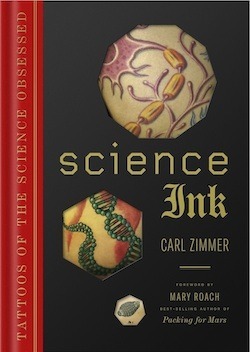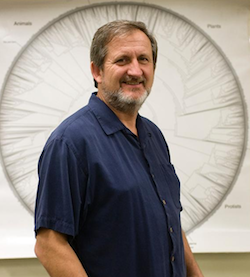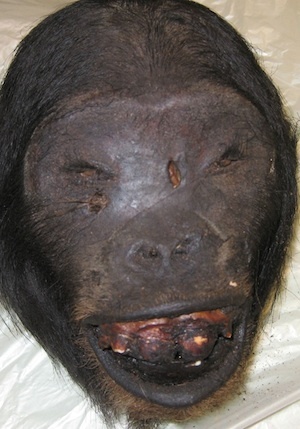Carl Zimmer's Blog, page 51
January 19, 2012
Science Ink in New York: This Tuesday
 This Tuesday I'll be giving a talk at the New York Academy of Sciences about Science Ink–complete with live tattooed scientists!
This Tuesday I'll be giving a talk at the New York Academy of Sciences about Science Ink–complete with live tattooed scientists!
Here are some of the details…
When: Tuesday, January 24, 2012, 7:00 PM – 8:30 PM. (A reception will follow.)
Where: The New York Academy of Sciences
7 World Trade Center
250 Greenwich Street, 40th floor
New York, NY 10007-2157
212.298.8600
Get $10 dollars off full-price tickets by using the promo code ZIMMER. Register here: http://www.nyas.org/scienceink
See you there!
January 18, 2012
Evolving Bodies: A Storify follow-up
In yesterday's New York Times, I wrote about a new paper in which scientists report the evolution of single-celled yeast into multicellular snowflake-like "bodies." Most (but not all) of the experts I contacted for the story had high praise for the study. (It also won an award when it was presented as a talk over the summer at the Society for the Study of Evolution.) Once the story appeared, however, some scientists took to Twitter to express their skepticism. As much as I like Twitter, this is one of the situations where it fails. You can't have a conversation about genetics, lab strains versus wild types, etc., in 140 character chunks. At least not very satisfying ones.
So here's what I decided to do last night. I used Storify to collect the comments of Leonid Kruglyak of Princeton and Michael Eisen of Berkeley, and then passed them on to Will Ratcliff, the lead author of the new study. He then responded. Below you'll find the Storify tweets, and then Ratcliff's response. Please continue the conversation in the comment thread. (And be sure to download the paper–it's open access.)
[View the story "Yeast evolving" on Storify]
Will Ratcliff responds:
Well, I ...
January 16, 2012
Evolving Bodies: My new story in tomorrow's New York Times
 In the history of life, single-celled microbes have evolved into multicellular bodies at least 25 times. In our own lineage, our ancestors crossed over some 700 million years ago. In tomorrow's New York Times, I write about a new study in which single-celled yeast evolved into multicellular forms–completely with juvenile and adult forms, different cell types, and the ability to split off propagules like plant cuttings. All this in a matter of weeks. Check it out.
In the history of life, single-celled microbes have evolved into multicellular bodies at least 25 times. In our own lineage, our ancestors crossed over some 700 million years ago. In tomorrow's New York Times, I write about a new study in which single-celled yeast evolved into multicellular forms–completely with juvenile and adult forms, different cell types, and the ability to split off propagules like plant cuttings. All this in a matter of weeks. Check it out.
(The paper is not yet online yet, but here's the reference: "Experimental evolution of multicellularity," William C. Ratcliff, R. Ford Denison, Mark Borrello, and Michael Travisano. Proceedings of the National Academy of Sciences. http://www.pnas.org/cgi/doi/10.1073/pnas.1115323109 )

January 15, 2012
A Hot Young Earth: My Answer to the Annual Edge Question
 Each year, literary agent and science salonista John Brockman poses a question about science and gets a slew of answers from scientists, writers, and other folks. This year's question is
Each year, literary agent and science salonista John Brockman poses a question about science and gets a slew of answers from scientists, writers, and other folks. This year's question is
WHAT IS YOUR FAVORITE DEEP, ELEGANT, OR BEAUTIFUL EXPLANATION?
Brockman got 187 responses, totaling some 126,700 words. A book, you say! Well, if this year is like previous ones, this year's answers will indeed become a book. But in the meantime, you can browse the answers for yourself, perhaps plucking out those of your favorite people. (Fellow Discover blogger cosmologist Sean Carroll chooses Einstein's explanation of gravity, for example.)
I found this year's question particularly thought-provoking. Why is it that we call an equation or a theory "beautiful"? They don't have pretty hazel eyes. They aren't desert landscapes. I'm not sure of the answer. Scientific explanations seem to be beautiful if they give sense to confusing complexity in a very short space. Or maybe we just like the feeling we get when we consider how our puny human brains can interpret the universe.
For a lot of physicists, the beauty of an equation seems to be a good hint that it's ...
January 13, 2012
Words bring life to life
Drew Berry is one of the great movie-makers of the molecular world. He makes gorgeous computer visualizations of DNA, proteins, and the various goings-on inside the cell. Last night I spent a little time watching a new TEDx talk of his just posted online. My first thought was, "Why didn't I get to see these movies when I was learning about biology as a kid? Life is unfair." Compared to the flat cartoons of textbooks, or even the crude animations in documentaries of yore, Berry's work seems to come from some advanced alien civilization.
In case you haven't seen Berry's work before, I've embedded his lecture here. (You may have heard about him when he got a recent Macarthur "genius" grant.) If you have seen his stuff before, I'd suggest you watch this anyway. And this time, don't just watch. Listen.
When I first saw Berry's work a while back, I was immediately gob-smacked. But as I watched his synchronized swimming of molecules a while longer, I realized after a while that I didn't understand a lot of what was going on. I didn't know the names of the molecules I was looking at, and, more importantly, I couldn't tell what ...

January 12, 2012
Inside Darwin's Tumor
Cancer evolves. Those two words may sound strange together. Sure, birds evolve. Bacteria evolve. But cancer? The trouble arises from the fact that cancers, unlike birds and bacteria, are not free-living organisms. They start out as cells inside a person's body and stay there, until they're either wiped out or the person dies.*
Yet the same forces that drive the evolution of free-living organisms can also drive cancer cells to become more aggressive and dangerous. Evolution becomes our inner foe if mutations disable a cell's self-restraint. The cell multiplies. Sometimes a new mutation arises in its descendants. If the mutations allow the cancer to grow faster, the cells carrying it will take over the population of cancerous cells. Natural selection and other processes that drive evolution on the outside start driving it on the inside.
Like so many other scientists, researchers who study cancer evolution have jumped on new technology for sequencing genomes on the cheap. They're now starting to publish fine-grained histories of the disease, tracking individual mutations as they arise and spread. Nature has just published a fine example of this new research. I particularly appreciated the informative pictures they came up with to accompany ...
January 11, 2012
Life with a capital L? (Like Zimmer with a capital Z?)
 Over on Facebook, David Hillis, an evolutionary biologist at the University of Texas, took up my question as to whether anyone can define life in three words. His short answer was no, but his long answer, which I've stitched together here from a series of comments he wrote, was very interesting (links are mine):
Over on Facebook, David Hillis, an evolutionary biologist at the University of Texas, took up my question as to whether anyone can define life in three words. His short answer was no, but his long answer, which I've stitched together here from a series of comments he wrote, was very interesting (links are mine):
Like all historical entities (including other biological taxa), it is only sensible to "define" Life ostensively (by pointing to it, noting when and where it began, and following its lineages from there) rather than intensionally (using a list of characteristics). This applies to the taxon we call Life (hence capitalized, as a formal name). You could define a class concept called life (not a formal taxon), but then that concept would clearly differ from person to person (whereas it is much less problematic to note examples of the taxon Life). So, I'd say that I can point to and circumscribe Life, and that it the appropriate way to "define" any biological taxon. A list of its unique characteristics is then a diagnosis, rather than a definition. So, I'd argue that any ...

Science Ink on this week's Science Friday
I'll be on National Public Radio's Science Friday this week to talk about Science Ink. Host Ira Flatow and I will be chatting during the 3 pm EST hour. In the meantime, the folks at Science Friday have set up a slide show preview.
Can you define life in three words?
We are all sure we know what life is, but if you try to actually define it, things get tricky fast. I wrote a feature about the scientific struggle to define life in 2007 for Seed, and I've been keeping tabs on the evolution of this metaphysical quandary ever since. I was particularly intrigued to discover recently that one scientist thinks he can define life–and do so in just three words. I've written an essay about his short and sweet definition for the web magazine Txchnologist. Check it out.
January 10, 2012
Any deadly viruses to declare?

Today, a company called Ion Torrent announced they were going to start selling a DNA-sequencing machine that can sequence an entire human genome for $1,000. It's just the latest milestone in the long-term crash in the cost of gene-reading. There are lots of benefits that will flow from this ongoing transformation. For one thing, as I wrote in 2010 in the New York Times, it's getting easier to identify new viruses that could turn to be the next HIV or SARS.
To research my story, I paid a visit to the Center for Infection and Immunity at Columbia University. On the day I dropped by, Ian Lipkin and his colleagues were very busy:
Some researchers were examining New York flu, others African colds. The blood of patients with mysterious, nameless fevers was waiting to be analyzed. There was dried African bush meat seized by customs inspectors at Kennedy Airport. Horse viruses, clam viruses: all told, members of Dr. Lipkin's team were working on 139 different virus projects. It was, in other words, a fairly typical day.
Some of the research that was going on that day–specifically, the ...












